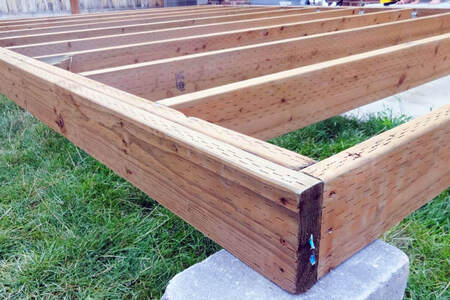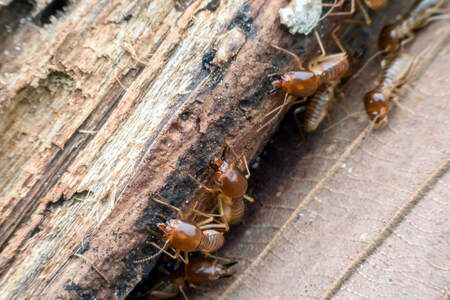
Guide to DIY Deck Framing
Would you like a deck that complements your patio furniture? This guide to DIY framing a deck will help you learn how to do it yourself.
Read Full StoryAre you fed up repeatedly replacing your wood deck boards because of warping? We see you and understand your annoyance.
We have put together a few effective preventive measures and simple tricks to save you from frequent trips down this lane. However, to eliminate a problem from its roots, we should know its exact cause.

That said, we’ll first discuss in detail why warping deck boards happen and then move on to how to fix warped composite decking. So, keep reading to find out.
Warping is simply twisting timber from its supposed shape due to adverse weather conditions, which cause decking to warp. Uneven shrinkage is the root cause of such disfigurement.
Whenever timber is exposed to rain, it absorbs water, causing thermal expansion and expanding slightly. Later, when the surroundings return to their normal dry state, the wood loses that water and tries to contract back to its average size.
At this point, trouble occurs because it tends to lose its original shape when the wood dries up too quickly or slowly.
Another point worth noting is that it’s not just rain or sun that causes warping, as certain woods are “hygroscopic” in nature. For those who don’t know, this is the property of wood by which it passively absorbs water from a humid environment.
Wood can warp in many different ways. Let’s quickly take a glimpse at the most common types:

In this type of warping, the wood deviates from its straight structure and twists towards one side.
Bowing is the most common type of wood distortion. In this, the wood plastic decking section assumes a bow shape lengthwise, with no change across the width.
You might have come across twisted warping in wooden stairs or fences. In this type, the timber warped decking twists in shape, and all four corners end up unaligned and out of position.
Cup-warping is not that common. It is the same bow type, but the distortion is along the width instead of the length.
You must note that wood warping depends on factors like wood species, airflow, grain orientation, finishing quality, etc. Now that you are acquainted with the basic know-how of the problem, we can proceed to find its efficient solutions.

The prevention should begin right off the bat when installing the wood decking. If you are considering renovation or installing composite decking, read this section carefully.
Paying attention to these small details will help you increase the longevity of your deck boards.
Wood grains can affect the quality of timber more than you know. The grain pattern affects lumber’s reaction when it adapts to moisture.
For instance, a straight grain texture with less than 0.8 mm pore space doesn’t warp as readily as others. Additionally, wood chopped from the core of a tree is relatively stable and doesn’t shrink.
another crucial factor is how the sawing technique can cause wood to warp like that. You might find it difficult to believe, but the timber processing methodology influences the warping.
In a flat-sawn board, both edges are at an equal distance from the tree’s heart. Therefore, it’s less likely to get crooked. Furthermore, a quarter-sawn board has symmetrical annual rings, which occur evenly.
A fluctuation in sawing speed and poor maintenance can lead to uneven thickness of the wooden boards, causing them to be bulkier in the middle. This is how bow-type deformities occur, and you can prevent them by sawing at a steady pace.
The curing and drying process limits various types of warping in wood (except for cooking). A few key points to bear in mind while seasoning your wood are:
Now, if patchy drying leaves your wood uneven, sealing its ends can help. You will find that maximum moisture escapes the boards from their edges, causing a warped deck. This means unsealed ends shrink faster than the sealed ones, causing the wood to warp.
This technique will do the trick when there is damage, but the wood is at a curable stage. You need to unscrew the boards, flip them, and screw them back after drilling new holes.
Make sure that this time around, you use more screws than before; six is the magic number here. Following the proper installation instructions will keep the boards tightly secured at their respective places.
Hence, while nailing down the boards, use two pairs, each at one end and two towards the outer edge, near the joists. In this way, the wood will not have enough space to twist or move. Also, we advise using long nails or screws of about 15 mm for added stability.
You might wonder that moisture is the culprit here; why would we want to worsen the situation by adding more? Hold that thought; we’ll clarify it in a bit.
The boards shrink and develop bow-type warping if the moisture leaves the surface too fast. We can fix this shrinking by bringing the moisture content to an optimum level and exerting uniform pressure.
You can do that by pouring water on the timber until it pools. Leave it for around fifteen minutes; now, we know you will feel sceptical doing that, but trust us, it will be helpful. The wood will absorb most of the water but wipe away whatever’s left after fifteen minutes.
After the above step, the boards will become somewhat pliable and bent, and once this threshold is reached, you’re ready for the next part. Fix the timber in the desired place using a rigid structure like an iron tube and a clamp.
Lastly, leave them to let your composite decking boards dry in a well-ventilated place, avoiding direct sunlight, and you’ll be good to go.
When only a few decking sections are warped, replacing and installing your new composite deck might be advisable instead of putting in the extra effort. Pull out the distorted composite boards and replace them with new ones.
This method is your best bet if you have leftover matching warped wood.
The best way to save your deck board from harsh weather conditions is to protect your natural wood decking with high-quality paint. You’ll find many warping prevention paints on the market that are budget-friendly and effective. With just a few coats, your deck will look new, the decking will not warp, and you will be safe from further damage. Also, remember to maintain your warped composite deck regularly.
We have reached feel the outdoor decking beneath your feet without worrying about warping. After covering its root causes, types, preventive, and fixing methods for composite decking warps, hoping it was worth your time.
Wood warps can be annoying, and replacing the entire composite deck can burn a hole in your pocket. But with our tips, you’ll be able to get away without spending much while ensuring that the deck remains beautiful and long-lasting.
Talk to our team specialising in plastic decking at Final Touch if you need assistance with your composite deck boards in Sydney. Our team has years of experience with deck installation, maintenance, and repair.
On that note, we’ll be signing off. Take care, folks, and we’ll see you next time!
Would you like a deck that complements your patio furniture? This guide to DIY framing a deck will help you learn how to do it yourself.
Read Full StoryLooking for ways to protect your decking from termite colonies? We’ve got you covered with our guide. Final Touch cover everything you need to know about termites and your timber deck.
Read Full StoryThis article covers the different types of finishes available for timber decks, including oil-based and water-based options, as well as the pros and cons of each type. Find out how to choose the right finish for your deck.
Read Full Story

